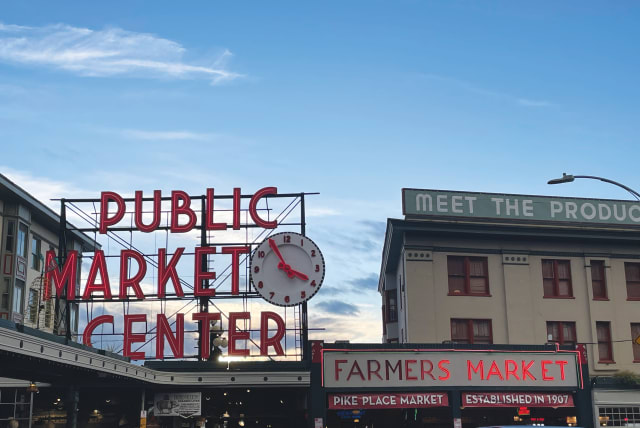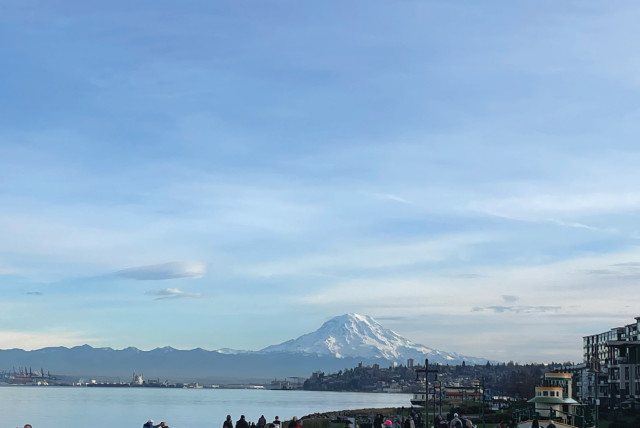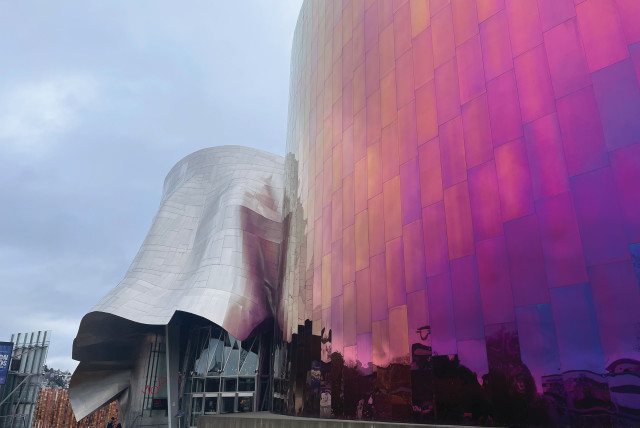Soaking in Seattle (and Tacoma)

If you’re planning a visit to Seattle and/or its sister city, Tacoma, it’s best to come equipped with foul-weather gear because it would be a shame to spend all your time indoors
Israel recently experienced more than 14 straight days of rainfall throughout the country for the first time since February 1992 – but it’s still not as rainy as Seattle.
While in Jerusalem, it typically rains around 4.8% of the time, in Seattle, it’s rainy 9.4% of the time. While Jerusalem sees about 59 cm of rain per year, in Seattle, it’s 94 cm on average, though climate change is causing both more dry spells and heavier downpours.
So if you’re planning a visit to Seattle and/or its sister city, Tacoma, it’s best to come equipped with foul-weather gear because it would be a shame to spend all your time indoors, even though you could – the Seattle area has more than 40 museums.
If you’re in a hurry – for example, you’ve only got a short stop in Seattle before setting off on an Alaska cruise – it’s possible to take in Seattle’s “greatest hits” in just one day.
Start at the top – at Seattle’s iconic Space Needle. It stands 184 meters tall and was built for the 1962 World’s Fair. Once the tallest building on the West Coast, it’s now dwarfed by downtown skyscrapers.
In keeping with the Fair’s theme, “The Age of Space,” the Needle is topped with what looks like a flying saucer.
The upper level of the saucer offers panoramic views of downtown, Mount Rainier (aka Mount Tacoma), Puget Sound, and the Cascades and Olympic mountain ranges – if they’re not obscured by clouds.
The lower level has a glass floor and rotates – which is great for making videos and very bad if you suffer from vertigo.
Tickets for the Space Needle start at $35 but are around half price if you invest in a Seattle CityPASS, which will also get you into several of the other attractions mentioned below.
You can avoid waiting in line by booking your timed visit in advance on the Space Needle website using your Seattle CityPASS.
The next stop is just a few steps from the base of the tower: Chihuly Garden and Glass, dedicated to the work of Seattle glass artist Dale Chihuly.
More than a million visitors saw the Chihuly in the Light of Jerusalem 2000 exhibit at Jerusalem’s Tower of David Museum from 1999-2000, and some of the same works are on display in Seattle.
A SHORT stroll away is MoPOP – the Museum of Pop Culture. The distinctive building, clad in sinuously curving multichromatic stainless steel and painted aluminum shingles, was designed by star architect Frank O. Gehry – born Frank Owen Goldberg – who was told by teachers at USC’s School of Architecture to change his name if he wanted to get ahead.
MoPOP is a shrine to pop music and pop culture, with an emphasis on modern music (from Hendrix to hip-hop), science fiction, fantasy, horror, and video games.
(By the way, Jimi Hendrix’s first gig was as a teenager in 1959, on the stage of Seattle’s Temple De Hirsch Sinai. The legendary guitar player was fired before the end of the first set for playing too wildly.)
MoPOP’s science fiction collection includes more than 150 artifacts, including a Ghostbusters Proton Pack, a Klingon Bat’leth, Ellen Ripley’s flamethrower from Alien, and Rick Deckard’s pistol from Blade Runner.
Many of the exhibits are hands-on, allowing visitors to experiment with animation, video game design, and making music.
Just across the street is the more serious-minded Bill & Melinda Gates Foundation Discovery Center, with exhibits on programs to fight poverty, disease, and inequity around the world. An exhibition opening in late February is entitled A Better Way to Go: Toilets and the Future of Sanitation.
The most fun way to get from the Seattle Center, where the above attractions are located, to downtown Seattle is via the elevated monorail, which runs right through MoPOP. Built for the World’s Fair, it takes two minutes to travel the 1.4-km. route. At night, the lights inside the cars are lowered, allowing a voyeuristic view into the windows of passing third-floor offices.
One of Seattle’s architectural landmarks is a nine-minute walk from the monorail stop. The Central Library is an 11-story glass and steel structure that looks something like a wireframe model of a Tesla Cybertruck. It was designed by Rem Koolhaus (known as “the World’s Most Controversial Architect,” according to Smithsonian Magazine) and Seattle native Joshua Ramus.
Another nine-minute walk takes you to the Seattle Art Museum, with its 15-meter-tall mobile sculpture – Johnathan Borofsky’s Hammering Man – honoring working-class men and women.
The Pike Place Market offers a plethora of restaurant options
AT THIS point, you’re probably more than ready for something to eat. Luckily, the Pike Place Market is only a six-minute walk from the museum.
The Market, founded in 1907, encompasses restaurants, food stands, specialty food shops, retailers, and a farmers’ market selling local produce. It smells strongly of fish.
The Market can be very crowded, especially on weekends, and one of the longest lines is likely to be outside the original Starbucks. Tourists from around the world make a pilgrimage to this standing-room-only coffee shrine to collect branded souvenirs only available at this location.
If you still have any energy left after this busy day, you can finish up in the hip Capitol Hill neighborhood, about a 10-minute cab ride from Pike Place, where you can find Blade & Timber, Seattle’s premier axe-throwing bar, alongside drag clubs, vintage boutiques, and comic book shops.
Tacoma, Seattle’s sister city (they share Sea-Tac Airport, located midway between them) is about a 40-minute drive from Seattle (with optimal traffic) and is also accessible via train or bus. It’s not as popular with tourists, but it’s less expensive than Seattle and can be a convenient base of operations for exploring the area.
If your taste for glass hasn’t been sated by the Chihuly Museum, you can also visit the Tacoma Museum of Glass and the Chihuly Bridge of Glass, topped by what looks like two enormous stalks of Brussels sprouts.
Nearby, next to the Tacoma Dome and the train station, is the LeMay Car Museum. With more than 3,000 cars, it’s one of the largest automobile museums in the world.
Also near the Tacoma Dome is the Tacoma Book Center, the biggest used bookstore in the state of Washington, with a particularly large collection of children’s books.
Back downtown, Tacoma’s Antique Row is located around Broadway between 9th and 7th. Hands-on nostalgia is available by the quarter at Dorky’s Arcade, with its collection of vintage and modern video games and pinball machines.
When you’re ready to brave the elements – or take advantage of the rare sunshine – the Ruston Way Waterfront is a 3.2-km. paved walking path connecting downtown Tacoma with Point Defiance Park and the Dune Peninsula.
One section of the path commemorates Frank Herbert, the Tacoma native who authored Dune. The trail is dotted with quotes from his work and features a sculpture of sand trout (baby sandworms).
The Seattle-Tacoma area has dozens of Jewish congregations, including about 25 Chabad centers.
A handful of kosher dining options include the Gold Schnitzel (Meat) Restaurant, Pabla Indian Cuisine in the suburb of Renton, and Einstein Brothers Bagels in University Village. The QFC grocery stores in University Village and on Mercer Island offer kosher rotisserie chickens, sushi, deli meats, and side salads.
Jerusalem Post Store
`; document.getElementById("linkPremium").innerHTML = cont; var divWithLink = document.getElementById("premium-link"); if (divWithLink !== null && divWithLink !== 'undefined') { divWithLink.style.border = "solid 1px #cb0f3e"; divWithLink.style.textAlign = "center"; divWithLink.style.marginBottom = "15px"; divWithLink.style.marginTop = "15px"; divWithLink.style.width = "100%"; divWithLink.style.backgroundColor = "#122952"; divWithLink.style.color = "#ffffff"; divWithLink.style.lineHeight = "1.5"; } } (function (v, i) { });


